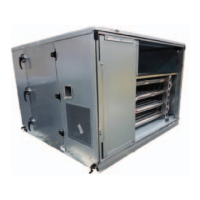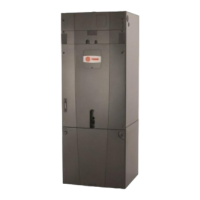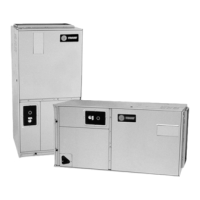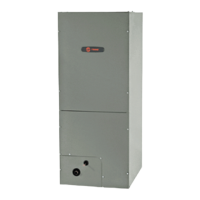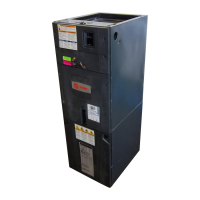CLCH-SVX07K-EN 143
Routine Maintenance
WARNING
Hazardous Service Procedures!
Failure to follow all of the safety warnings provided,
could result in death or serious injury. The maintenance
and troubleshooting procedures recommended in this
manual could result in exposure to electrical,
mechanical or other potential safety hazards. Always
refer to the safety warnings provided throughout this
manual concerning these procedures. Unless specified
otherwise, disconnect all electrical power including
remote disconnect and discharge all energy storing
devices such as capacitors before servicing. Follow
proper lockout/tagout procedures to ensure the power
can not be inadvertently energized. When necessary to
work with live electrical components, have a qualified
licensed electrician or other individual who has been
trained in handling live electrical components perform
these tasks. .
WARNING
Rotating Components!
Failure to secure rotor or disconnect power before
servicing could result in rotating components cutting
and slashing technician which could result in death or
serious injury. The following procedure involves
working with rotating components. Disconnect all
electric power, including remote disconnects before
servicing. Follow proper lockout/ tagout procedures to
ensure the power can not be inadvertently energized.
Secure rotor to ensure rotor cannot freewheel.
Maintenance Checklist
Table 52.Maintenance checklist
Frequency Maintenance
After 48 hours
of operation
• For belt-drive fans, the belts have acquired their permanent set. Readjust but do not overtighten. See “Tension the Fan Belt,” p. 130
for more information.
Every week
• Observe unit weekly for any change in running condition and unusual noise.
Every month
• Clean or replace air filters if clogged or dirty; change bag filters when pressure drop is 1 in. w.g. See “Filters,” p. 162 for more
information.
• Permanent filters located in outdoor air intake hoods should be cleaned monthly. This time frame should be altered if needed due to
seasonal issues, i.e., high pollen levels in the spring or leaves in the fall.
• Belt-drive fans - relubricate fan bearings if necessary. See “Fan Bearing Lubrication,” p. 161 for more information.
• Belt-drive fans - check and adjust fan belt tension.See “Tension the Fan Belt,” p. 130 for more information.
Every three to
six months
• Belt-drive fans - check fan bearing grease line connections. Lines should be tight to the bearings.
• Check motor bracket torque. See Table 53, p. 161 for torque requirements.
• Belt-drive fans - check bearing bolt torque and bearing setscrew torque. See Table 53, p. 161 for torque requirements.
• Belt-drive fans - align fan and motor sheaves. Tighten sheave set screws to the proper torque. See “Align Fan and Motor Sheaves,”
p. 132 for more information.
• Inspect and clean drain pans. See “Drain Pans,” p. 147 for more information.
• Tighten electrical connections.
• Inspect coils for dirt build-up. See “Coils,” p. 145 for more information.
• Clean moisture eliminator with high pressure sprayer. Remove pollen in the spring and leaves in the fall. See “Moisture Eliminator,”
p. 162.
Every year
• Inspect the unit casing for corrosion. If damage is found, clean and repaint.
• Clean the fan wheels and shaft. See “Fans,” p. 160 for more information.
• Inspect and clean drain pans.
• Check damper linkages, set screws, and blade adjustment. Clean, but do not lubricate, the nylon damper rod bushings.
• Clean damper operators.
• Inspect electrical components and insulation.
• Inspect wiring for damage.
• Rotate the fan wheel and check for obstructions. The wheel should not rub. Adjust the center if necessary.
• Lubricate motor bearings in accordance with motor manufacturer’s recommendations (see “Motor Bearing Lubrication,” p. 161 for more
information).
• Check condition of gasketing and insulation around unit, door and dampers.
• Examine flex connections for cracks or leaks. Repair or replace damaged material.

